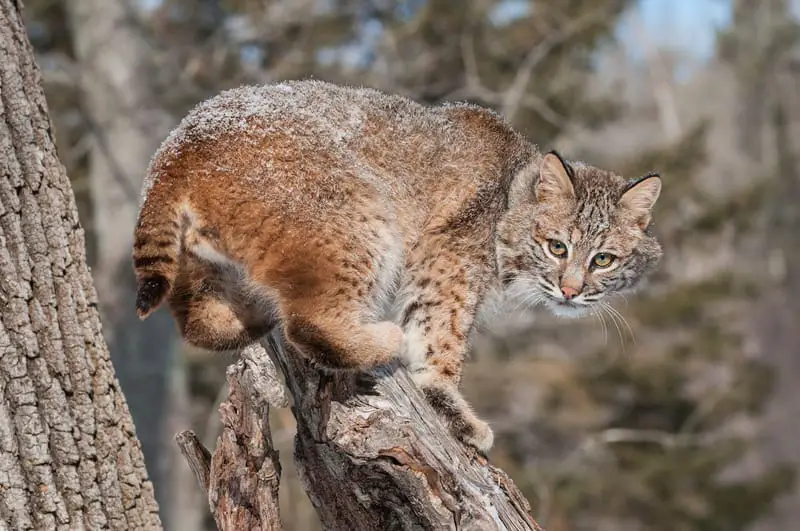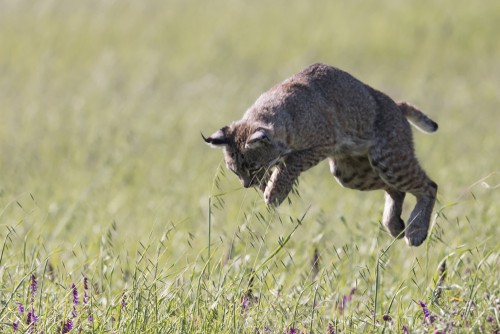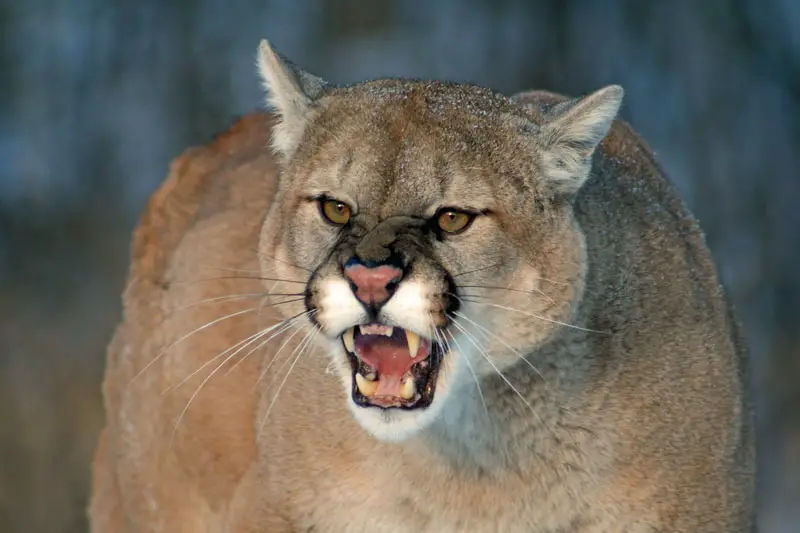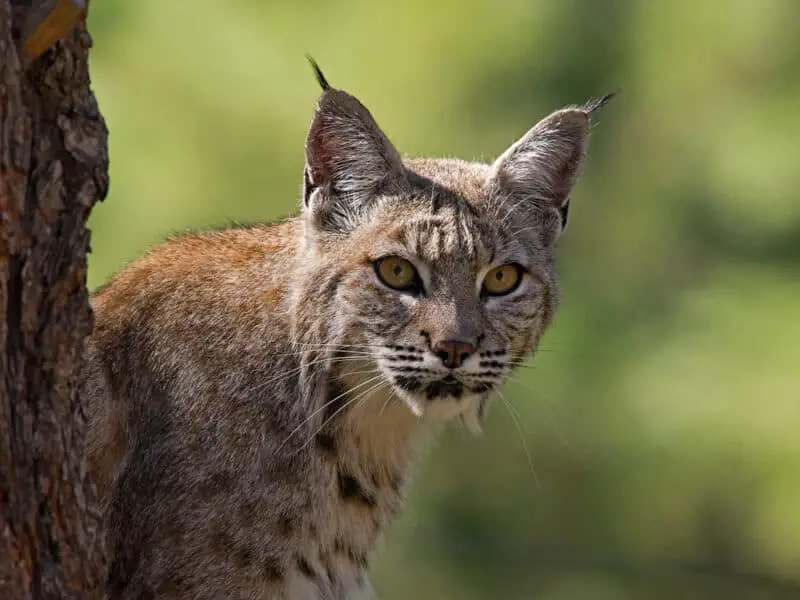The bobcat is currently the state of Maryland’s only wild cat species.
Mountain lions are native to Maryland. However, even though the Maryland Department of Natural Resources receives reports of mountain lion sightings from time to time, these big feline predators are considered to be extirpated from the state.
In the paragraphs below, we’ll talk about both of these wild cats.
Bobcats in Maryland (Lynx rufus)
The bobcat, which is also known as the red lynx, the bay lynx, or the swamp tiger, is a North American wild cat. Biologists believe that both the bobcat and the Canada lynx are descendants of the Eurasian lynx whose ancestors crossed into North America via the Bearing Sea land bridge.

What do bobcats look like?
Adult bobcats are similar to their close relative, the Canadian lynx, in appearance, with some differences. An Adult bobcat is slightly smaller than an adult Canada lynx.
Compared to Canadian lynx, which thrive in deep snow country, bobcats struggle more in the snow due to the fact that they cannot walk on top of it as lynx can. A lynx’s large paws function like snowshoes keeping it on the snow’s surface. They have evolved this characteristic to hunt snowshoe hares in the winter. On the other hand, compared to lynx, bobcats have small feet that tend to sink into the snow. If the snow is too deep and powdery, it reduces their mobility along with their ability to catch prey.
A bobcat is roughly twice the size of a domestic house cat. They are 2 to 3 feet long and weigh 15 to 35 pounds. Adult male bobcats are around 33% larger than female bobcats.
These animals have “bobbed,” short tails with black tips and black bars on the upper surface. The black tip on their tail is only on its upper surface but not the back. As opposed to a lynx’s tail which looks like it was dipped in black paint.
Their fur is usually gray to brown, with mottled dark spots that range from black to dark brown on their bodies. “A note on this is that in the eastern U.S., bobcats have fewer spots on their bodies than bobcats in the west do.” They also have black stripes on their inner forelegs and tail.
From a side view, you will notice that a bobcat is slightly higher at the rump than at the shoulders. Bobcats and lynx have long hind legs in proportion to their forelegs.
Bobcats have black-tufted ears. In other words, they have short tufts of black hair that poke up above their ears that are black at the tips. The backs of their ears, below the black tips, are black. In the center of the black of each ear, they have a single white spot. This gives the impression of a false eye on the back of each ear.
They also have a whiskered face that seems broader due to their prominent face ruff and whiskers. Their eyes are yellow with round black pupils.
In 2020, film footage of a rare black bobcat was taken near Danville, Vermont. See. These melanistic bobcats have all the markings that non-melanistic ones do. They manifest as darker black spots on top of lighter black or dark grey.
Where do bobcats live?
Bobcats reside only in parts of North America. They’re also the most common wild cat in North America. Their range begins in southern Canada and then extends south through most of the continental United States and down into central Mexico.
The history of bobcats in Maryland is similar to that of black bears in the state. These wild cats were much more abundant before the time of European colonization. After the state was initially settled by Europeans beginning in the 1600s, its forests were greatly degraded. Also, its wildlife was hunted in an unregulated fashion. Consequently, populations of the state’s predators, including the grey wolf, the black bear, the mountain lion, and the bobcat, declined sharply. While wolves and mountain lions no longer exist in Maryland, bobcats, along with black bears, have staged a comeback that began with the regeneration of some of the state’s second-growth forests.
According to Harry Spiker, who is a Maryland Wildlife and Heritage Service game mammal section leader, today, bobcats live predominately in western Maryland in Allegany, Garrett, Washington, and Frederick counties. However, to a smaller extent, they live as far east as the Atlantic Ocean at the western shore of Chesapeake Bay. See
Bobcat sightings are rare because they are shy creatures and mostly a nocturnal or crepuscular animal. Your best chances of spotting one are in the early morning and early evening hours.
A Bobcat is generally a solitary animal. The exceptions to this generality are during breeding season and when a female is raising young. They are territorial and live in a home range that they patrol and scent mark with urine and feces.
The size of their home ranges varies with the geography and the availability of prey. Male bobcat home ranges are generally larger than female bobcat home ranges.
It’s also important to note that while female home ranges do not overlap, a male bobcat’s home range might overlap with the home ranges of several female bobcats.
Other than their inability to cope with deep snow, bobcats are pretty versatile and tend to utilize all the different habitat types within their range. In Maryland, wild bobcats inhabit rugged types of habitat such as rocky ledges, hardwood forests, swamps, bogs, and brushy areas. They also exist in but are less frequently in areas adjacent to agricultural land, and suburban areas. They also seem to thrive in wooded areas in close proximity to clear cuts. Studies show that small mammal populations increase in clear-cut areas. This is due to the improved food and cover conditions that a clear-cut creates. See
In urban surroundings, it’s not unheard of for a bobcat to stake out someone’s backyard bird feeder.
Sometimes people in rural or even suburban and urban residential areas have bobcats in the neighborhood, and they don’t realize it. It’s a very rare occurrence, but sometimes these animals will end up in someone’s home or garage. If you ever accidentally corner a bobcat, immediately give it some space. Back away and leave a door open for it to escape on its own. For your own and the animal’s safety, never approach a cornered bobcat. Cornered, they are dangerous animals that will do their best to tear you up if they feel the need to defend themselves. If you have an intruding bobcat that won’t leave on its own, call on your local DNM officer and or an animal control officer to remove it for you.

What do bobcats eat?
Despite being a small animal, a bobcat is an aggressive, tough predator. They are the personification of opportunistic feeders. They prey on a wide variety of wild animals. At times, particularly during the winter, they take larger animals that are quite a bit bigger than they are, such as deer. In Maryland, for instance, they sometimes prey on white-tailed deer.
However, their regular diets mainly consist of small mammals such as cottontail rabbits, woodchucks, eastern gray squirrels, American red squirrels, fox squirrels, southern flying squirrels, chipmunks, and small rodents like mice, and voles. They also feed on reptiles, birds, insects, and carrion. When they take up residence close to residential or rural areas, their menu might occasionally also include domestic pets, small farm animals, and poultry.
They even prey on venomous snakes when the opportunity arises despite not being immune to the venom. They accomplish this by using their quickness to pin the snake’s head down with a paw, after which they dispatch the snake with a quick bite to its spine behind the head with their sharp teeth.
The two venomous snakes that live in Maryland are the Eastern Copperhead (Agkistrodon Contortrix) and Timber Rattlesnakes (Crotalus horridus). See
Reproduction and life cycle for Eastern Bobcats in Maryland
In Maryland, mating season for bobcats occurs between January and April. Bobcats are polygamous. This means that a male bobcat may mate with multiple females.
If they successfully mate, the gestation period for bobcats is 60 days.
After breeding, the male and female go their separate ways. Other than in the exceptions of breeding and raising young, they’re solitary animals.
The female takes all responsibility for the selection of a den site and the rearing of the young.
Bobcats often use rock crevices as den sites but may also den in the cavity beneath an overturned stump or beneath a blown-down tree,
In Maryland, the bobcat litter size ranges from 1 to 7 kittens, but most contain 2-3.
Bobcat kittens are born with their eyes sealed, just like domestic cats are. However, their eyes will open when they are a week to 10 days old. By the time they are 2 months old, they will have replaced their spotted baby fur with a haircoat similar to what their parents have.
By mid-July, the kittens begin to venture out with their mothers to fine-tune their survival skills. Their training may last into the early winter. By mid-winter, the kittens strike out on their own.
Female bobcats reach sexual maturity at 1 year of age, while males reach sexual maturity at age 2.

Are There Mountain Lions in Maryland?
It’s been a very long time since the presence of mountain lions has been confirmed in Maryland. The big cats are native to the Old-Line State, just as they are to the entire eastern seaboard. However, habitat loss due to human population growth and overhunting led to their extirpation sometime in the 19th century.
What’s more, eastern mountain lions had disappeared from the entirety of the eastern United States and Canada, with the exception of southern Florida by the early twentieth century. In fact, in 2018, the U.S. Fish and Wildlife Service removed the eastern cougar from their endangered species list and declared them to be extinct.
The closest known mountain lion populations to Maryland are in Florida, Nebraska, and South Dakota, respectively.
Having said all the above, it’s not beyond the realm of possibility that mountain lions come to the state of Maryland on occasion.
Sub-adult male mountain lions sometimes travel hundreds of miles from established breeding populations as they seek to establish their own territory, free from dominant toms.
A famous case of this occurred in 2011 when a male mountain lion traveled all the way from South Dakota to be struck and killed by a vehicle on a Connecticut highway. See
What do mountain lions look like?
To visualize what a mountain lion looks like, picture a giant house cat with short, light brown fur. Mountain lions are much larger than domestic cats, though. Average house cats weigh in at around 10 pounds, while male mountain lions can weigh over 200 pounds.
These large cats have muscular slender bodies, rounded small heads, and upright ears that are oval at the tip. Another characteristic that mountain lions have is their muscular long tails, which account for almost one-third of the entire length of the animal. They use their long tail for a counterbalance, moving it from side to side as they navigate through uneven terrain.
Mountain lions have a tan coat of short, coarse hair over most of their body. The area around their nose, the tip of their tail, and the tips of their ears are black. Their belly, the area above their upper lip, below their lower lip, and their chin are all white. They also have a sprinkling of dark hair on their backs. There are some coat color variances between different geographic locations.
Mountain lions are the second largest cats in the Western hemisphere, smaller only than the Jaguar (Panthera onca). However, worldwide, the African Lion, (Panthera leo) and the Tiger (Panthera tigris) are also larger.
Male and female mountain lions are phenotypically identical in every respect except for size. Males are 30 to 40% bigger than females. Though sizes vary considerably throughout the cat’s geographic range, an adult male typically weighs between 110 and 180 pounds, 50 to (82 kgs). A rare few of them grow bigger than 200 pounds (91kgs). Female mountain lions or queens average between 80 and 130 pounds (36 to 59 kgs). Adult males or toms will reach a length of 6 to 8 feet (1.8 to 2.4 M) from their snout to the tip of their tail. On the other hand, adult females are 5 to 7 feet long (1.5 to 2.1 M).
Large cats but not big cats
An interesting fact is that while an adult mountain lion might be a large cat or maybe even a big cat, they are not taxonomically classified as big cats because they cannot roar. A Snow leopard, for example, is smaller than a mountain lion. However, since snow leopards can roar and cannot purr, they are classified as big cats, while mountain lions are not. Another interesting thing that I can mention here is that mountain lions purr.
Since they purr and cannot roar, mountain lions are in the Felis genus, while big cats that cannot purr and can roar are in the Panthera genus.
Biologists taxonomically divided mountain lions into 2 sub-species in 2017. The first is (Puma concolor couguar) or northern cougar. Northern cougars range through North America, Central America, and possibly northwestern South America. The second sub-species is (Puma concolor concolor) or southern cougar. These cats range only in South America.
Recent Posts
The only venomous snakes in Washington State are Northern Pacific Rattlesnakes. The Northern Pacific Rattlesnake (Crotalus oreganus oreganus) is a sub-species of the Western Rattlesnake. Anyone...
Skunks are not classified as true hibernators. But they go into a state of torpor when the weather gets cold. Skunks are light sleep hibernators, along with opossums, bears, and raccoons. ...

